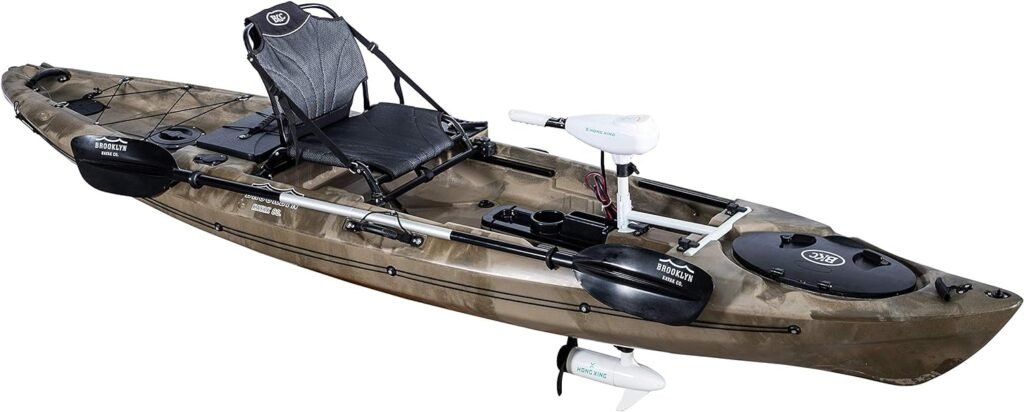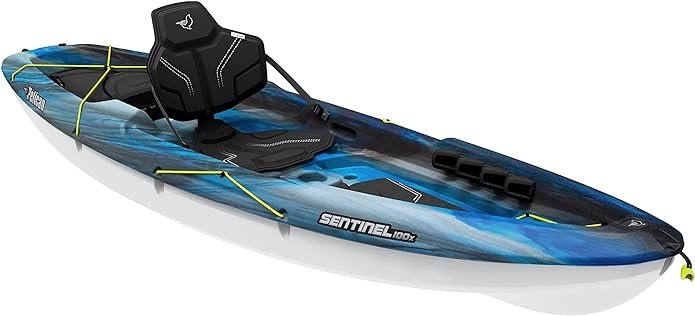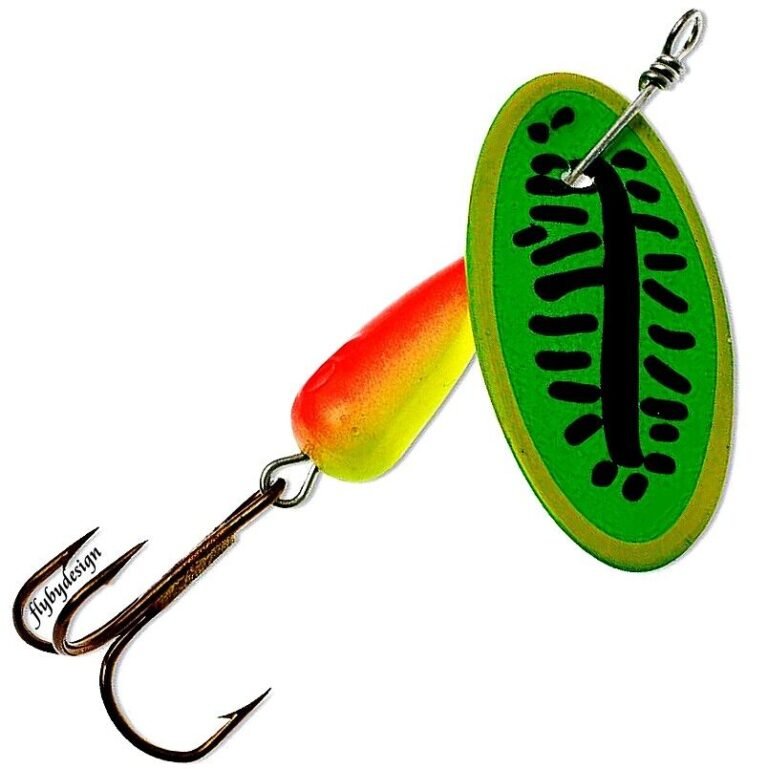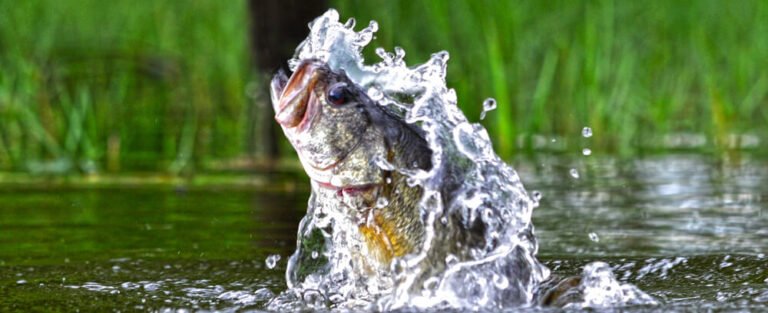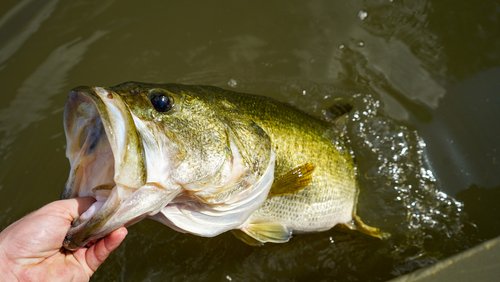Kayak bass fishing is a thrilling experience that involves utilizing a kayak while targeting bass species. Kayak fishing offers us a unique perspective by placing us closer to the water’s surface, creating a magnificent experience.
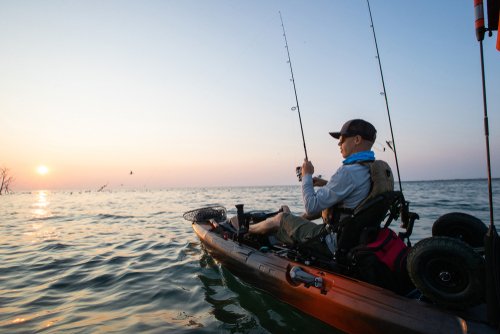
The angler sits in a specially designed kayak, with features such as rod holders and storage compartments to enhance their fishing experience. With its roots deeply embedded in paddling and angling culture, this sport has gained significant popularity due to its exciting challenges and rewards. Click here for our buyer’s guide or shop below.
Enhancing the Sport of Bass Fishing
Compared to traditional boat or shore fishing, kayak bass fishing is a superior choice, offering many distinct advantages. Unlike their larger boat counterparts, Kayaks excel in providing stealth on the water. Their sleek design permits anglers to glide near fish with minimal disturbance, significantly reducing the chances of scaring them away.
The agility of kayaks is another remarkable aspect. Their compact size and skill allow access to confined spaces and intricate waterways inaccessible to larger vessels. Shore fishermen do not share this advantage and are often constrained to land-accessible zones. In contrast, kayak anglers can traverse secluded and uncharted territories, uncovering hidden fishing havens teeming with sizeable bass.
Advantages of Kayak Bass Fishing
Kayak bass fishing transcends mere convenience, incorporating elements significantly elevating the angling experience. The stealth aspect is particularly noteworthy, achieved through a silent paddle or pedal system, as opposed to the disruptive motors of traditional boats. This quiet approach minimizes aquatic disturbances, thereby not alarming the fish and increasing the likelihood of a successful catch.
Moreover, the exceptional maneuverability of kayaks empowers anglers to deftly maneuver through winding waterways, shallow regions, and areas with dense foliage. This enables precise and accurate casts, significantly improving the probability of enticing elusive bass.
Additionally, kayaks grant access to remote, often overlooked locations that other fishing methods fail to reach. These isolated areas typically host less-disturbed fish populations, offering more frequent bites and the potential for larger hauls to adventurous kayak anglers who dare to explore these hidden gems.
The Best Kayaks for Bass Fishing
- Sleek Speed: Long hull with built-in motor for steady cruising.
- Travel Ready: Water-tight storage hatches and rear cargo space.
- Fishing Friendly: Rod holders, cupholder, and adjustable seat.
- Includes: Ergonomic seat, rudder, and paddle.
- Retail: $1340
- Storage: Front, tank well, and removable compartment
- Stable: Twin-arched multi-chine hull; easy entry/exit.
- Safe: Extra flotation, 275 lb capacity, scupper holes.
- Lightweight: Durable polyethylene, 9 ft 6 in, 42 lb.
- Retail: $588
Choosing the Right Kayak for Bass Fishing
Types of kayaks available for bass fishing
When choosing a kayak for bass fishing, several options cater to different preferences and fishing styles. One popular choice is the sit-on-top kayak, which provides anglers with an open deck design and excellent stability. Sit-on-top kayaks are ideal for those who prefer easy access to gear and enjoy fishing in warmer climates where the ability to cool off in the water is a plus.
On the other hand, some anglers may opt for a sit-inside kayak that offers more protection against water splashes and cooler temperatures. Sit-inside kayaks are advantageous in colder climates or when fishing in rougher waters where staying dry is crucial.
Another option gaining popularity among anglers is pedal-driven kayaks. These innovative kayaks allow fishermen to use their legs instead of relying solely on paddling, providing more convenience and freeing their hands for casting and reeling.
Factors to consider when selecting a kayak
Choosing the right kayak requires careful consideration of various factors that ensure an enjoyable and efficient fishing experience on the water. Stability plays a significant role; you’ll need a stable platform while maneuvering around or casting your line. Look for kayaks with wider hulls or pontoon-style designs that offer enhanced stability without sacrificing speed or maneuverability.
Weight capacity is another vital aspect, as it determines how much gear you can bring without compromising safety or performance. Ensure that your chosen kayak has enough capacity to accommodate your weight and additional equipment such as tackle boxes, coolers, and camping gear if needed.
Storage options are equally crucial since you’ll want ample space to store your rods securely during transportation and compartments to organize and keep your gear accessible while on the water. Look for kayaks with built-in rod holders, hatches, and bungee cord systems that provide versatile storage solutions.
Features that enhance the angler’s experience
To optimize your kayak bass fishing experience, having specific features on your kayak can dramatically enhance your capabilities on the water. Rod holders are essential for keeping your fishing rods secure and within reach while paddling or maneuvering. Look for kayaks with multiple rod holders strategically placed around the cockpit or along the sides for easy access and efficient rod management.
Additionally, installing a fish finder on your kayak can greatly increase your chances of success by helping you locate schools of bass and identify underwater structures where they may be hiding. Fish finders use sonar technology to provide real-time data about water depth, temperature changes, and fish presence below the surface.
Some advanced models even offer GPS functionality to mark hotspots or create custom maps of productive fishing areas. Incorporating these features into your kayak setup will make you a more effective angler and add convenience and enjoyment to every fishing expedition.
Essential Gear for Kayak Bass Fishing
Fishing rods and reels suitable for kayak use
Several factors need careful consideration when selecting the best fishing rods and reels for kayak bass fishing. Firstly, the length of the rod is crucial as it affects casting distance and accuracy. Opting for a medium-length rod between 6.5 and 7.5 feet is generally recommended as it balances maneuverability and control.
Power is another aspect to assess; choosing a medium-heavy or heavy-power rod ensures sufficient strength to handle aggressive strikes from bass while maintaining control in tight spaces. As for materials, graphite or carbon fiber are ideal for materials due to their lightweight nature without compromising durability.
Tackle selection is based on different conditions and species.
As any experienced angler knows, having a well-stocked tackle box is essential for success on the water. Regarding kayak bass fishing, versatility is key since you’ll target various species in different conditions. Start with a selection of soft plastic baits like worms, creature baits, and swimbaits that mimic natural prey items and can be used effectively in different situations.
Include an assortment of topwater lures, such as buzz baits or poppers, for enticing surface strikes in calm conditions or during low-light periods. Additionally, ensure you have a range of spinnerbaits, crankbaits, and jigs in your tackle arsenal to cover various depths and water structures.
Safety equipment required for kayaking
Safety should always be paramount when engaging in water-based activities like kayaking or bass fishing. Personal flotation devices (PFDs) are necessary to provide buoyancy and ensure safety if unforeseen circumstances arise. Choose a PFD specifically for kayaking, offering a comfortable fit and unrestricted movement to avoid hindering your angling experience.
Additionally, it is crucial to have signaling devices on board, such as a whistle or horn, which can attract attention in emergencies or navigational needs. A waterproof flashlight and a fully charged mobile phone in a waterproof case are also crucial tools that should not be forgotten.
Equipping Yourself for Kayak Bass Fishing Success
The right gear is the foundation of an enjoyable and successful kayak bass fishing experience. Selecting the appropriate fishing rods and reels tailored for kayak angling, along with a well-curated selection of tackle based on different conditions and target species, ensures you are fully prepared for any situation you may encounter on the water. Remembering to prioritize safety by equipping yourself with personal flotation devices and essential signaling devices will provide peace of mind and allow you to confidently navigate the waters from your trusty kayak while pursuing your passion for bass fishing.
Techniques for Successful Kayak Bass Fishing
Understanding the behavior patterns of bass
To become a successful kayak bass angler, it is crucial to deeply understand the behavior patterns exhibited by bass during different seasons and weather conditions. During spring, for example, bass tend to be more active and aggressive as they prepare to spawn.
Knowing this, anglers can focus their efforts in shallower areas near the spawning grounds by flipping or pitching soft plastic baits into cover. In contrast, bass often seek cooler water depths or shady areas during hot summer to stay comfortable.
This calls for adapting techniques such as deep diving crankbaits or drop-shotting finesse worms in deeper waters where the fish are likely holding. By studying the behavior patterns of bass throughout the year, anglers can adjust their approach accordingly and increase their chances of success.
Casting techniques from a seated position in a kayak
Kayak fishing requires anglers to master casting techniques from a seated position while maintaining balance on the watercraft. When casting from a kayak, it is essential to have good body rotation and utilize shorter casts for better accuracy. Aiming low with your cast helps avoid getting tangled in overhead obstacles like tree branches or tall grass.
Additionally, utilizing sidearm or underhand casts proves advantageous due to limited overhead clearance on most kayaks compared to traditional boat fishing. These casting techniques will enhance your ability to make precise presentations while ensuring maximum control over your bait placement.
Tips on locating prime spots using sonar technology
Identifying prime fishing spots is paramount for any angler seeking success on the water. Still, kayak bass fishing becomes even more critical due to limited mobility compared to larger boats. Utilizing sonar technology proves invaluable for locating underwater structures, drop-offs, or submerged vegetation where bass tend to gather. By interpreting the sonar’s display and identifying potential fish-holding areas, kayak anglers can accurately pinpoint productive spots.
Additionally, reading water features such as current breaks, points, or submerged structures visible on the surface can provide valuable insights into where bass may be lurking. Observing the presence of baitfish activity or other indicators like bird activity can also guide anglers toward promising areas.
These multifaceted strategies enable kayak bass fishermen to effectively target prime spots and improve their chances of hooking into that trophy-sized bass. Incorporating these techniques and strategies into your kayak bass fishing endeavors will elevate your angling experience.
Understanding bass behavior patterns throughout different seasons and weather conditions empowers you to decide when and where to fish. Mastering casting techniques from a seated position enables accurate presentations while maintaining control in a kayak.
Harnessing the power of sonar technology and honing water reading skills aids in locating prime fishing spots that increase your chances of success on the water. By embracing these techniques and constantly refining your skills, you will soon find yourself reaping the rewards of an exhilarating and fulfilling kayak bass fishing adventure.
Challenges Faced in Kayak Bass Fishing
Dealing with Wind, Currents, and Other Factors
One of the primary challenges kayak bass fishermen face is navigating through wind, currents, and other environmental factors while maintaining stability on their kayaks. Wind can significantly affect the angler’s ability to paddle efficiently and control the kayak’s direction.
Understanding how wind affects water movement and utilizing proper techniques, such as paddling into the wind at an angle, can help maintain stability. Similarly, strong currents can make staying in position or maneuvering effectively difficult.
Adjusting paddle strokes and using anchor systems are crucial for maintaining stability in such conditions. Moreover, being aware of other environmental factors like waves, tides, and obstacles will allow anglers to adapt their techniques accordingly and ensure a stable fishing platform.
Managing Limited Storage Space on Kayaks
Managing limited storage space is another challenge kayak bass fishermen face during expeditions. Unlike boats with ample deck space, kayaks have limited room for storing fishing gear, tackle boxes, personal belongings, and equipment for a successful fishing trip.
Efficient organization is key to maximizing storage space on a kayak. Utilizing specially designed storage compartments or attaching additional gear tracks can help organize gear vertically rather than horizontally.
This allows for better weight distribution and minimizes clutter in the deck area, which could impact stability or hinder casting abilities. Additionally, using dry bags or waterproof containers ensures that sensitive equipment stays safe from water damage while taking advantage of any available storage space.
Overcoming Physical Challenges During Long Trips
Kayak bass fishing often involves long trips where physical endurance is vital to an angler’s success. Paddling for extended periods can lead to fatigue, affect overall performance, and pose safety risks. Kayak bass fishermen must maintain good fitness through regular exercise and conditioning to overcome physical challenges.
Strengthening core muscles, arms, and shoulders will improve paddling efficiency and reduce the risk of injury. Taking breaks and stretching during longer outings is also essential to prevent muscle stiffness or cramps.
Proper paddling techniques, such as rotating the torso rather than relying solely on arm strength, can help conserve energy. Using pedal-driven kayaks or incorporating electric trolling motors can provide relief during long treks, allowing anglers to rest their muscles while staying mobile on the water.
Advanced Techniques in Kayak Bass
The Art of Topwater Fishing: Fooling Bass on the Surface
Mastering topwater fishing techniques can truly elevate your kayak bass fishing game. When the water is calm, and the conditions are right, luring bass to strike at surface baits can provide a heart-pounding experience. Explore the various types of topwater lures, such as poppers, prop baits, and buzz baits, each designed to imitate different prey and trigger aggressive strikes.
Learn the art of proper presentation, including creating a realistic action with precise rod movements and using strategic pauses to entice bass into biting. Patience and observation are key when engaging in this exhilarating technique.
Deep Diving Techniques: Exploring Submerged Structures
Understanding deep diving techniques is invaluable to targeting elusive bass lurking in deeper waters or around submerged structures. Dive into the world of crankbaits and diving plugs that can reach depths where big bass often reside. Familiarize yourself with different diving depths and shapes of lures to cover various water columns effectively.
Experiment with retrieve speeds and patterns to mimic injured baitfish or trigger instinctual reactions from bass hiding below. Honing your deep diving skills opens up a new realm of opportunities for catching those trophy-sized fish.
Conclusion
Kayak bass fishing combines a passion for angling with an unparalleled connection to nature’s serenity. The thrill of stealthily navigating pristine waters while pursuing trophy-sized bass is unforgettable. While challenges may arise regarding environmental factors or physical endurance during long trips, they only enhance the sense of achievement when successfully overcoming them.
Through this article’s exploration of basic techniques like casting from a seated position and advanced approaches such as topwater lure manipulation or deep diving strategies, it’s clear that kayak bass fishing offers endless opportunities for growth and improvement. Embrace the learning process, keep pushing your boundaries, and remember that every moment on the water is an opportunity to connect with nature and appreciate the beauty of this beloved sport.
You can become a masterful kayak bass angler with dedication, patience, and a thirst for adventure. So grab your paddle, set out on new waters, and let the bass fishing journey continue!

